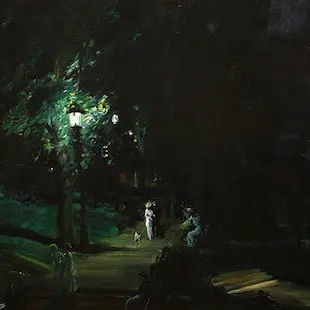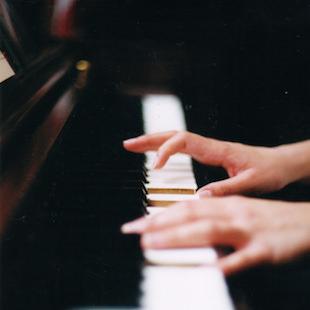Seventh Chords
Seventh chords shape the mood and texture of piano music across almost all genres. Learn how they work to spice up your music-making!
Last updated on 29 May 2024
Note: You'll gain the most from this article if you have a basic knowledge of scales, major and minor chords and diminished chords.
Seventh chords are an essential part of expanding your harmonic range on the piano. They shape the mood and texture of piano music across almost all genres, from Baroque-era classical to modern-day pop.
In this article, we introduce the seventh note and explain how it's used to build the five most common seventh chords: major, minor, dominant (aka "major/minor"), half-diminished and diminished seventh chords. We'll explore how each of the chords sound and how you can use them, then hear some famous examples of them in action.
What's a seventh note?
There are seven notes in any scale, named for their position relative to the first note of the scale — also known as the tonic. The seventh note is thus the last note in the scale. Since the positions of these notes can vary in different types of scales, there are a few types of seventh notes.
Major seventh note
The major seventh note corresponds to the seventh note in a major scale. For example, the seventh note of C major is B, so when the root of a chord is C, the major seventh note would be B.
In a chord, the major seventh note is always 5.5 steps above the root note. Here's an easier way to remember it: one octave up, one half step down.
Minor seventh note
The minor seventh note is the seventh note in a minor scale. For example, the seventh note in a C minor scale is B♭, so when the root of the chord is C, the minor seventh note would be B♭.
In a chord, the minor seventh note is always five whole steps above the root note. Here's an easier way to remember it: one octave up, one whole step down.
Diminished seventh note
When it comes to the diminished seventh note, you don’t have to worry about relating it to a type of scale. You can think of it as being a half step closer to the root than the minor seventh note — in other words, it's 4.5 steps above the root note. So, when the root of a chord is C, the diminished seventh note is A.
Notice the pattern!
You may have noticed that each of the seventh notes mentioned above are half a step closer to the root note than the previous. With C being the root, the major seventh note would be B, the minor seventh note would be a half step down at B ♭, and the diminished seventh note would be another half step down at A.
What's a seventh chord?
A seventh chord takes a major, minor or diminished triad and adds a major, minor or diminished seventh note (in most cases). Here, we'll focus on the five most common seventh chords:
- Major 7th chord — A major triad plus a major seventh note
- Minor 7th chord — A minor triad plus a minor seventh note
- Dominant 7th chord — A major triad plus a minor seventh note
- Half-diminished 7th chord — A diminished triad plus a minor seventh note
- Diminished 7th chord — A diminished triad plus a diminished seventh note
On their own, major, minor and diminished triads evoke simple yet distinct emotions. The fourth note in a seventh chord adds an extra layer of harmony, which brings a different flavor to the basic triad.
Below we'll dive deeper into each type of seventh chord.
Major seventh chords
A major seventh chord is a major triad with a major seventh note added.
To play a major seventh chord on the piano using your right hand, start with the major triad, but instead of using your first, third and fifth fingers, place your first, second and third fingers on the root, third and fifth notes, respectively. This might be a little uncomfortable at first if you have small hands, but with practice you'll be able to cover a wider range comfortably over time.
Now, place your fifth finger on the major seventh note, which is two steps up from your third finger / the fifth note. If your hands are larger, you may prefer to use your fourth finger for this. Go with whatever is more comfortable. It should look — and sound — like this:
The purely "happy" or "light" sound of a major chord is suddenly so much richer and more evocative when it's transformed into a major seventh chord. It adds an emotional element, which is why Romantic-era piano pieces, jazz music, and modern piano ballads use a lot of major seventh chords.
In sheet music, you might see the major seventh chord written in one of these ways: maj7, M7, Δ, ⑦. The most common form is maj7, where any alterations, added tones or omissions are sometimes also superscripted, such as Cmaj⁷.
Songs using a major seventh chord
Gymnopédie No. 1 — Erik Satie
This gentle masterpiece perfectly illustrates how a major seventh chord can create a dreamy, nostalgic feeling — and Satie uses it to great effect, evoking deep emotions with seemingly simple yet harmonically sophisticated choices.
"Everything I Wanted" — Billie Eilish
A major seventh chord starts the main progression of this delicate, evocative ballad, then returns throughout every section. It's a great example of how the chord can make even minimalist songs sound richer.
Minor seventh chords
A minor seventh chord is a minor triad with a minor seventh note added.
To play a minor seventh chord on the piano with your right hand, start with the minor triad and — like with a major seventh chord — place your first, second and third fingers on the root, third and fifth notes.
Now, place your fifth finger on the minorseventh, which is 1.5 steps up from your third finger / the fifth note. If your hands are larger, you may prefer to use your fourth finger. Again, go with whatever is more comfortable. It should look — and sound — like this:
Similarly to the major seventh chord, adding the seventh note introduces richness, this time softening the "sad" sound of a minor chord to make it more reflective than dark. Again, Romantic-era pieces, jazz music, and modern piano ballads all use a lot of minor seventh chords.
In sheet music, you might see the minor seventh chord written in one of three ways: Cm7, Cmin7 or C–7.
Songs using a minor seventh chord
"The Scientist" — Coldplay
The minor seventh chord at the start of the chorus progression brings some hope and light to what might have felt simply sad with a minor triad.
Nocturne No. 2 in E♭, Op. 9 — Frédéric Chopin
While primarily in E♭ major, this nocturne contains sections that feature minor seventh chords, adding to the piece’s emotional and lyrical quality.
Dominant seventh chords
A dominant seventh chord — also known as a major/minor seventh — is a major triad with a minor seventh note added.
The name major/minor seventh, as you may have guessed, comes from the fact that it's made up of a major triad plus a minor seventh note. Its other name, dominant seventh, comes from the fact that it is often built on the fifth — or “dominant” — note of a major scale.
To play a dominant seventh chord on the piano with your right hand, start with the major triad, placing your first, second and third fingers on the root, third and fifth notes.
Now, place your fifth finger on the minorseventh note. You can use your fourth finger instead if it's more comfortable. It should look — and sound — like this:
The combination of a major third with a minor seventh gives dominant seventh chords an innate dissonance, which can make them more impactful than other seventh chords. More than any other seventh chord, the dominant seventh creates a strong pull to return, or "resolve," to the home key. Because we naturally wait for the dissonance to resolve, dominant seventh chords are a great way to add a sense of movement to music.
In sheet music, dominant chords are written with just a 7 next to the name of the root, like this: C7 or C7.
Songs using a dominant seventh chord
Prelude No. 1 in C, BWV 846 — Johann Sebastian Bach
This flowing work of art features a dominant seventh chord as the third in the progression. It sounds almost playful and resolves back to the first chord oh-so-sweetly.
"Imagine" — John Lennon
In John Lennon's dreamy anthem "Imagine," there's this standout moment with the dominant seventh chord right on the words "living for today," in measures 29-31. It's as if the song is taking a deep breath before delivering its big, peaceful resolution.
Half-diminished seventh chords
A half-diminished seventh chord is a diminished triad with a minor seventh note added.
It is considered only “half” diminished because while it’s built on a diminished triad, the seventh note is not diminished, but minor.
To play a half-diminished seventh chord on the piano with your right hand, start with the diminished triad, placing your first, second and third fingers on the root, third and fifth notes.
Now, place your fifth finger on the minor seventh note.
The half-diminished seventh chord is a versatile chord, often used to amplify emotions, from mourning to celebration.
Songs using a half-diminished seventh chord
"Autumn Leaves" — Joseph Kosma
This popular jazz standard is beloved for its melancholic melody and rich harmonic structure. It prominently features half-diminished seventh chords in measures five and 25, which help to create the reflective, nostalgic mood that continues to captivate listeners.
"White Christmas" — Irving Berlin
In measure 14 of "White Christmas," the half-diminished seventh chord adds a touch of wistful longing to the melody. This chord's slightly unresolved quality enhances the song's nostalgic and dreamy mood, perfectly capturing the bittersweet side of Christmas.
Diminished seventh chords
A diminished seventh chord is a diminished triad with a diminished seventh note added.
It is considered “fully” diminished because it contains both a diminished triad and a diminished seventh note.
To play a diminished seventh chord on the piano with your right hand, start with the diminished triad, placing your first, second and third fingers on the root, third and fifth notes.
Now, place your fifth finger on the diminished seventh note. You can use your fourth finger instead if it's more comfortable.
Like the half-diminished seventh chord, the diminished seventh chord can be quite dramatic, so it is often used in operas to convey passion, anger or danger.
Songs using a diminished seventh chord
Toccata in Dm — Johann Sebastian Bach
Diminished seventh chords were relatively uncommon during the Baroque period, when Bach wrote this spooky classic. His use of this type of chord to add drama and complexity to this piece only emphasizes Bach's masterful understanding of harmonic language. You'll find the chord in measure seven.
"Waltz of the Flowers" — Pyotr Tchaikovsky
In this famous piece from The Nutcracker, Tchaikovsky masterfully employs diminished seventh chords to add harmonic tension and texture to the music, heightening its emotional and narrative impact. You'll find diminished seventh chords in measures six, 10, and many others that sound similar!
Seventh chords review
So far, here's what we've covered:
You can refer to this chart to remember the components of each type of seventh chord, and try to play each of them with C as the root. Once you're familiar with each type of seventh chord, try building them with other root notes!
The other seventh chords
After reviewing the chart, you may be thinking, "There's one missing!"
What about a minor chord with a major seventh? Well, it exists!
It's called the minor/major seventh chord and it's known for being very dissonant and spooky. In fact, Bernard Herrmann used it so much in his score for Alfred Hitchcock's classic horror movie Psycho that it's also known as The Hitchcock Chord.
There are seventh chords that are even less common, but you're unlikely to hear them much outside of film scores and jazz pieces, so we'll leave it at this for now!
Explore and learn more! Next steps and resources
Now that you understand the five most popular seventh chords, there are many ways you can continue learning. For one, the Improvising with Chords course in the flowkey app shows you how to improvise using seventh and other types of chords. You can also read up on ninth chords and sixth chords here in our chords library.
Another great way to apply your knowledge of seventh chords is by learning the song examples we've given above for each type of seventh chord — all of them are available in flowkey’s song library.
Pairing your musical journey with a reliable and fun learning platform like flowkey will keep you motivated and growing. With flowkey, you can explore seventh chords — and more — through engaging lessons and interactive song tutorials. We hope you'll check us out and discover the joy of playing music at your own pace.
Read next
Chord Inversions
Want to add depth, variety and fluidity to your piano playing? This article teaches you everything you need to know about chord inversions.
Major and Minor Chords
Learn all about major and minor chords, including how to play them and identify them in a piece of music.
How Long Does It Really Take to Learn the Piano?
Practicing the piano is something you can enjoy for a lifetime, but how long will it take until you can play your first song?
The 14 Classical Piano Pieces Every Musician Should Know
With centuries of history behind it, classical music deserves a spot on every pianist's playlist. Here are some of the most famous piano pieces from Baroque to Romantic.











